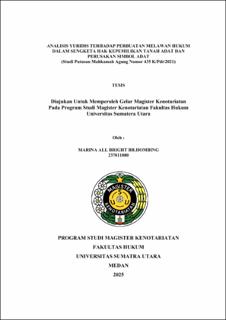Analisis Yuridis terhadap Perbuatan Melawan Hukum dalam Sengketa Hak Kepemilikan Tanah Adat dan Perusakan Simbol Adat (Studi Putusan Mahkamah Agung Nomor 435 K/Pdt/2021)
Juridical Analysis of Unlawful Acts in the Dispute Over Customary Land Ownership Rights and the Destruction of Customary Symbols (A Case Study of Supreme Court Decision Number 435/K/Pdv/2021)

Date
2025Author
Hombing, Marina All Bright Br
Advisor(s)
Sembiring, Rosnidar
Maria
Metadata
Show full item recordAbstract
Customary land disputes in Indonesia reflect the complexity of the
relationship between the national legal system and customary law, where
constitutional recognition through Article 18B paragraph (2) of the 1945
Constitution has not been fully effective in resolving ownership conflicts rooted in
cultural perception differences and economic interests. The case in Huta Lumban
Gambiri is a concrete representation of the dynamics of customary land conflicts
that require a comprehensive approach respectful of the traditional rights of local
communities. The research questions of this thesis are as follows: 1) What are the
legal characteristics of ulayat (customary) land in Indonesia's land law system
and customary symbols based on customary law? 2) How is legal protection
afforded to the ownership of Batak Toba customary land and traditional symbols?
3) How is the juridical analysis of unlawful acts in the dispute over customary
land ownership and the destruction of Batak Toba customary symbols, based on
Supreme Court Decision Number 435 K/Pdt/2021?
This study employs normative juridical legal research supported by
Interviews, A literature review was conducted to obtain secondary data, including
primary, secondary, and tertiary legal materials related to the research issues
The study 1s descriptive in nature and the data were analyzed qualitatively
The research findings Indicate that the legal characteristics of Batak Toba
ulayat land are communal-spiritual, with ownership based on patrilineal lineage
and genealogical-territorial identity manifested through customary symbols such
as the Hariara tree. Legal protection faces challenges due to the dualism between
constitutional recognition and the application of Western civil law. Although legal
regulations have evolved, further harmonization and recognition of the
immaterial value of customary symbols are still needed, The Supreme Court
Decision Number 435 K/Pdt/2021 recognizes the legitimacy of ulayat rights
within the framework of unlawful acts and accepts the historical Register De
Kampoengs as valid evidence However, the decision reflects inconsistency by
rejecting compensation for the destruction of the Hariara tree, indicating a lack
of understanding of the concept of immaterial loss in customary law.
Collections
- Master Theses (Notary) [2298]
